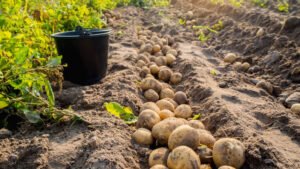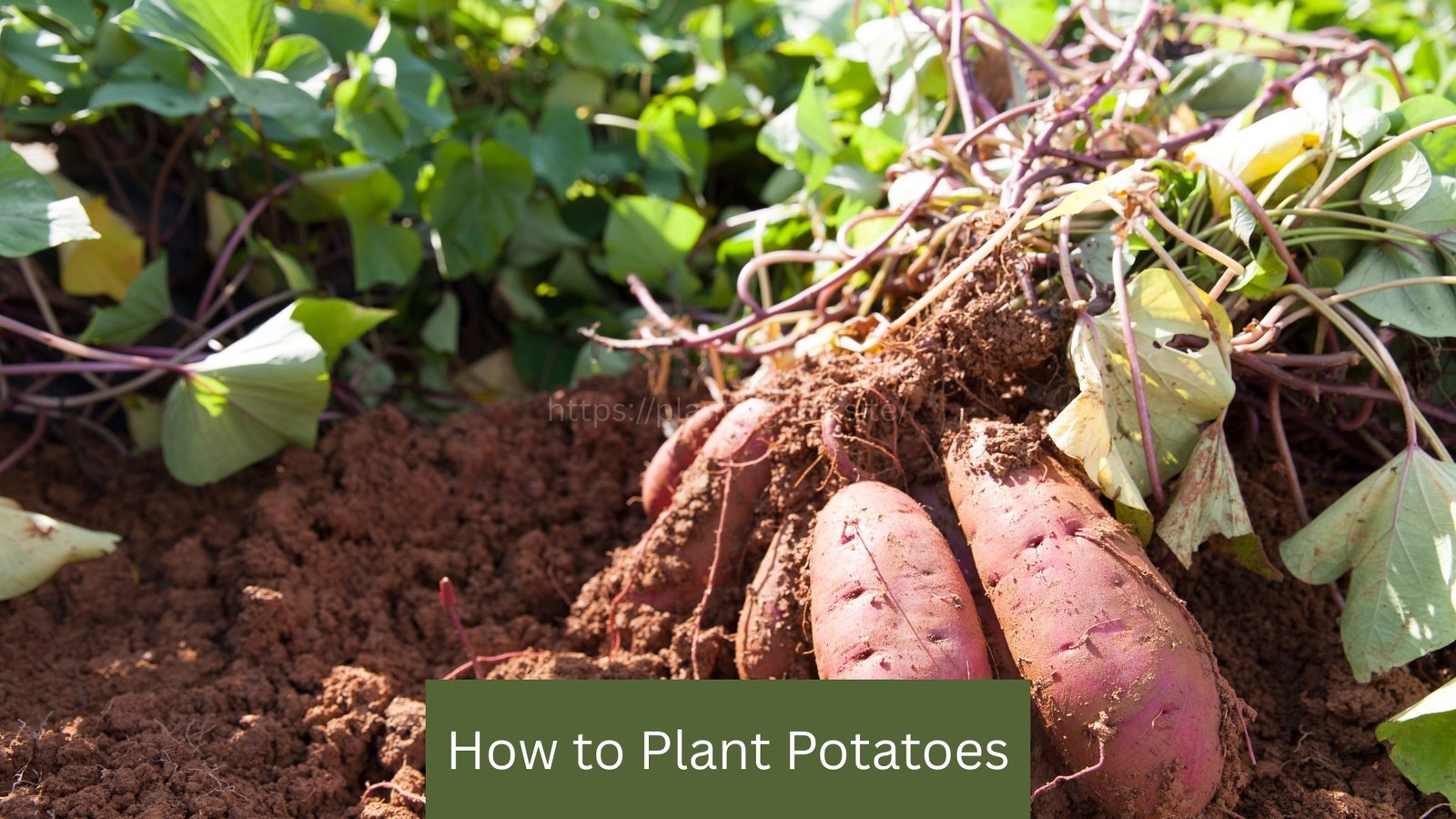Planting potatoes is a rewarding and fun experience that can be enjoyed by both beginner and seasoned gardeners. If you’ve ever wondered how to plant potatoes, you’ve come to the right place! Potatoes are easy to grow, offer great yields, and can thrive in many types of soil. Whether you’re planting a small patch or growing potatoes on a larger scale, this comprehensive guide will cover everything you need to know—from selecting seed potatoes to harvesting your crop.
Why Plant Potatoes?
Before diving into the planting process, let’s quickly touch on why you should grow potatoes. Potatoes are not only a versatile and delicious food, but they also require minimal care once planted. Plus, they are an excellent crop for beginners, as they grow in a variety of climates and conditions.
When you plant potatoes, you’re essentially planting “seed potatoes,” which are small potato tubers specifically used for growing new plants. By following proper planting techniques and providing your plants with the right care, you can harvest your own homegrown potatoes, making it a sustainable and satisfying gardening project.
Step 1: Choosing the Right Seed Potatoes
What Are Seed Potatoes?
When you plan to grow potatoes, you should start with seed potatoes, which are simply potatoes that are specifically grown for planting. These potatoes are free from disease and are known to produce strong and healthy plants. Avoid using grocery store potatoes, as they might carry diseases and can result in poor yields.
Seed potatoes can be bought from gardening stores or online, and they often come in different varieties, such as Russet, Yukon Gold, and Red Bliss. Each variety has its own characteristics, such as taste, texture, and resistance to pests. Choose a variety that suits your taste and your growing conditions.
How to Prepare Seed Potatoes
Before planting, you’ll need to prepare your seed potatoes. Here’s how:
- Cutting Seed Potatoes: If your seed potatoes are large, you can cut them into smaller pieces, ensuring each piece has at least one or two “eyes” (small sprouts). Make sure the pieces are about the size of an egg.
- Curing: Allow the cut pieces to cure for 2-3 days in a cool, dry place. This helps to form a protective layer over the cut edges, reducing the risk of rot once planted.
Sprouting: If you want to give your potatoes a head start, you can sprout them by placing them in a warm, light area for 2-4 weeks. This encourages the eyes to sprout, which speeds up the planting process.
Step 2: Preparing the Soil
Potatoes grow best in well-drained, loose soil. They require plenty of nutrients to grow, so it’s important to prepare your soil properly.
Ideal Soil for Potatoes
- Soil Type: Potatoes prefer sandy or loamy soil that drains well but retains enough moisture to keep the tubers hydrated.
- pH Levels: The ideal soil pH for potatoes is between 5.5 and 6.5. If your soil is too acidic, consider adding lime to balance it.
- Fertility: Add compost or well-rotted manure to improve soil fertility. Potatoes need rich soil to develop healthy tubers.
How to Prepare the Soil
- Loosen the Soil: Use a garden fork or shovel to loosen the soil to a depth of about 8-12 inches. This allows the tubers to grow freely and without obstruction.
- Create Mounds or Furrows: Potatoes are often grown in mounds or ridges, known as “hills.” These mounds help to keep the plants’ roots well-drained and allow for easy harvesting. To create a mound, pile up the soil about 6-8 inches high, leaving space between each mound for the plants to grow.
Step 3: Planting Potatoes

How Deep Should You Plant Potatoes?
Once your soil is prepared, it’s time to plant your seed potatoes. Place the seed potatoes 2-4 inches deep into the soil with the sprouted eyes facing upwards. Space the potatoes about 12-15 inches apart within the row. Rows should be about 2-3 feet apart to allow for enough space for the plants to grow.
Planting in Containers
If you’re limited on space, potatoes can be grown in containers as well. Choose a large, deep pot or container (at least 18 inches deep) with good drainage. Fill the bottom with soil, and place your seed potatoes on top. Cover with 4 inches of soil, and as the plants grow, continue adding soil to keep the tubers covered.
Companion Plants
Certain plants can help potatoes grow better by improving soil quality and repelling pests. Consider planting marigolds, basil, or garlic near your potatoes to improve their health and repel harmful insects like aphids and beetles.
Step 4: Caring for Potato Plants
Watering
Potatoes require consistent moisture, especially as they grow. Water your plants regularly, but be careful not to overwater, as this can lead to rotting. Aim for about 1-2 inches of water per week, depending on weather conditions.
Hilling
As your potato plants grow, you’ll need to “hill” them—this means adding more soil around the base of the plant. This helps to prevent the developing tubers from turning green (which can happen when they are exposed to sunlight) and supports the plant’s growth.
Fertilizing
In addition to compost, you may need to fertilize your potatoes with a balanced fertilizer that is rich in potassium and phosphorus. Avoid fertilizers that are too high in nitrogen, as this can promote excessive leaf growth at the expense of tuber development.
Pest and Disease Control
Potatoes are susceptible to several pests, including the Colorado potato beetle, aphids, and slugs. Regularly inspect your plants for signs of pests and remove them by hand if necessary. Organic insecticidal soap can be used for heavier infestations.
To prevent diseases, avoid planting potatoes in the same spot year after year. Rotate crops to reduce the risk of soil-borne diseases like blight.
Step 5: Harvesting Potatoes
Potatoes are typically ready to harvest 2-4 months after planting, depending on the variety and growing conditions. You’ll know it’s time to harvest when the plant begins to flower and the leaves start to turn yellow and die off. Gently dig up the potatoes using a fork, starting from the outer edges of the mound.
How to Harvest Potatoes
- Use a Fork or Shovel: Carefully lift the potatoes from the soil, being careful not to bruise them.
- Curing: After harvesting, let the potatoes sit in a dry, cool place for 1-2 weeks to cure. This helps them last longer in storage.
Step 6: Storing Potatoes
Store your harvested potatoes in a cool, dark place with good ventilation. A temperature between 40-50°F (4-10°C) is ideal. Keep them in a paper bag or cardboard box to ensure proper airflow.
FAQs About Planting Potatoes
1. When is the best time to plant potatoes?
The best time to plant potatoes is in early spring, about 2-4 weeks before the last expected frost. Potatoes prefer cool weather, so planting in early spring gives them the best chance to thrive.
2. How do I prevent my potatoes from turning green?
To prevent potatoes from turning green, ensure that the tubers are planted deep enough—at least 2-4 inches deep—and cover them with soil as they grow. Additionally, ensure they are not exposed to too much sunlight.
3. Can I grow potatoes indoors?
Yes! You can grow potatoes indoors in containers, provided they have access to plenty of light and a cool, dark place for curing after harvesting.
4. How long does it take for potatoes to be ready to harvest?
Potatoes are typically ready to harvest 2-4 months after planting, depending on the variety and growing conditions. Harvest when the plant starts to yellow and die off.
5. How do I know when my potatoes are ready to harvest?
Your potatoes are ready to harvest when the plant begins to flower, and the leaves turn yellow and die. Dig around the base of the plant and gently pull up the tubers.
6. Can I use any potato for planting?
It’s best to use certified seed potatoes for planting, as they are disease-free and specially grown for planting. Grocery store potatoes may carry diseases and result in poor yields.
By following this guide, you’ll be well on your way to growing a successful potato crop. Whether you’re a beginner gardener or an experienced grower, planting potatoes is a fun and rewarding way to enjoy fresh, homegrown food. Happy gardening!

